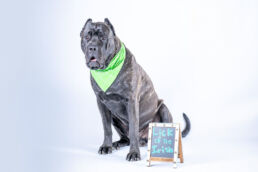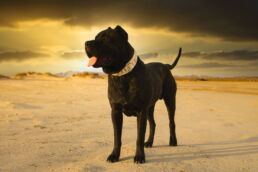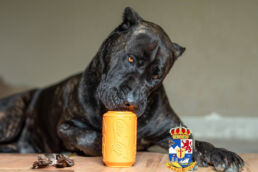PUPPY & ADULT DIETS
A dog is considered an adult when it has stopped growing, so in general the diet of a Presa can be changed to an adult one at about 18 months of age although the dog may take more time to fully mature physically. You should rely upon your breeder to recommend an acceptable maintenance diet, whether you choose to feed commercial food or a diet you create at home. It is necessary for you to select the type of diet best suited to your dog’s needs. Active dogs have different requirements than sedate dogs.
SENIOR DIETS
As dogs get older, their metabolism changes. The older dog usually exercises less, moves more slowly and sleeps more. This change in lifestyle and physiological performance requires a change in diet. Since these changes take place slowly, they might not be recognizable. What is easily recognizable is weight gain. By continuing to feed your dog an adult-maintenance diet when it is slowing down metabolically, your dog will gain weight. Obesity in an older dog compounds the health problems that already accompany old age.
As your dog gets older, few of its organs function up to par. The kidneys slow down and the intestines become less efficient. These age-related factors are best handled with a change in diet and a change in feeding schedule to give smaller portions that are more easily digested. There is no single best diet for every older dog. While many dogs do well on light or senior diets, other dogs do better on puppy diets or other special premium diets such as lamb and rice. Be sensitive to your senior Presa’s diet, as this will help control other problems that may arise with your old friend.
WATER
Just as your dog needs proper nutrition from his food, water is an essential “nutrient” as well. Water keeps the dog’s body properly hydrated and promotes normal function of the body’s systems. During house-training, it is necessary to keep an eye on how much water your Presa is drinking, but once he is reliably trained, he should have access to clean fresh water at all times, especially if you feed dry food. Make certain that the dog’s water bowl is clean, and change the water often.
EXERCISE
Exercise is important to the Presa, though the dog does not need to run-in wide-open spaces all day long. The Presa does not thrive if confined to a small area, such as a small yard. If your home only has limited accommodations for the Presa, then you must take your dog out daily to the park or any enclosed, safe area where the dog can run and play. Be sure that dogs are permitted in any public place that you choose to bring your Presa.
OBESITY AND BOREDOM
Bear in mind that an overweight dog should never be suddenly heavily exercised; instead encourage your dog to exercise slowly, in brief sessions. Not only is it exercise essential to keep the dogs body fit, it is essential to his mental well-being, A bored dog will find something to do, which often manifests itself in some type of destructive behavior. Exercise is essential for the Presa Canario dogs’ diet, as well as their mind.
There are many ways to provide the Presa with exercise; the best are those that give owner and dog interaction and time to spend together. Play is very important to the Presa, and the owner should involve himself in games with his dog. In a pack, wolves, very social animals like their relatives, dogs, are constantly playing games.
It is useful to realize that the canine is a gregarious creature and prefers to live among other dogs. Dogs prefer their own species to any other, including humans, though some silly owners choose to think otherwise. If circumstances permit, the author recommends you to acquire a male and a female. Do not get two same-sex animals, as quarrels will occur and sometimes these can have dire even grave outcomes. No matter how we try, we can never replace the company of another dog, but, nevertheless, we should return to the discussion of fun and games with your Presa.
RESPECT
The most important thing in your relationship with your Presa is how you treat him every day in your home and yard. Games are absolutely essential to your dog’s emotional balance. Dogs constantly play among themselves, so it’s your goal to engage the Presa in enjoyable activities, such as chasing a ball or flying disk or the like. Dogs use play to establish their emotional ties to and relationships among members of the pack. You are a member of the Presa’s pack-ideally the leader. Without hierarchy, dogs cannot function nor relate to one another. By your actions, being the one to initiate and carry out the “play,” your dog will come to know that you are the Alpha dog. Dogs are natural observers and understand their place in the family.
In caring for your Presa, establishing and enjoying a good relationship with your dog is as important as providing proper food, exercise and veterinary care. The rapport that you establish with your Perro de Presa Canario should provide constant benefits to both parties.
BRUSHING
Since the Presa Canario is a short-coated breed, very little grooming is required. A natural bristle brush or a hound glove can be used for regular routine brushing. Regular brushing is effective for removing dead hair and stimulating the dog’s natural oils to add shine and a healthy look to the coat. Even though the Presa’s coat is short and close, it does require a five-minute once-over every few days to keep it looking its shiny best. Regular grooming sessions are also a good way to spend time with your Presa. Many dogs grow to like the feel of being brushed and will come to enjoy the routine.
BATHING
Dogs do not need to be bathed as often as humans, but regular bathing is essential for healthy skin and a healthy, shiny coat. Presa Canario’s do not need to be bathed more than a few times per year, unless
they get particularly dirty or roll in something smelly. Again, like most anything, if you accustom your pup to being bathed as a puppy, it will be second nature by the time he grows up. You want your dog to be at ease in the bathtub or else it could end up a wet, soapy, messy ordeal for both of you!
Give your Presa a once-over with the brush or glove before wetting his coat. This will get rid of any debris and dead hair, which are harder to remove when the coat is wet. Make certain that your dog has a good non-slip surface on which to stand. Begin by wetting the dog’s coat, checking the water temperature to make sure that it is neither too hot nor too cold. A shower or hose attachment is necessary for thoroughly wetting and rinsing the coat.
Next, apply shampoo to the dog’s coat and work it into a good lather. Wash the head last, as you do not want shampoo to drip into the dog’s eyes while you are washing the rest of his body. You should use only a shampoo that is made for dogs. Do not use a product made for human hair. Work the shampoo all the way down to the skin. You can use this opportunity to check the skin for any bumps, bites or other abnormalities. Do not neglect any area of the body & get all of the hard to reach places.



Thank you for this information ‘I cant own a Presa in my country ‘ but it doesnt stop me educating myself as I own @ breed Bandogs . This breed seems similar in attitude somewhat. Just such a powerful canine @ very agile for their size. Truly wonderful. Yours kindly Bronson Davis ( Australia )